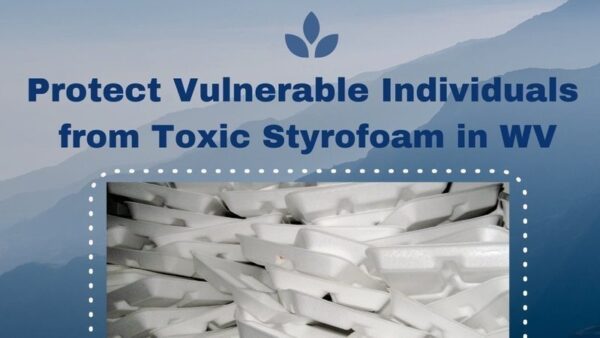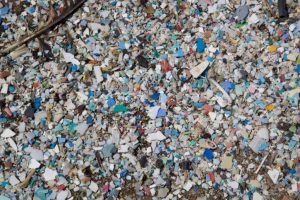- Like
- Digg
- Del
- Tumblr
- VKontakte
- Buffer
- Love This
- Odnoklassniki
- Meneame
- Blogger
- Amazon
- Yahoo Mail
- Gmail
- AOL
- Newsvine
- HackerNews
- Evernote
- MySpace
- Mail.ru
- Viadeo
- Line
- Comments
- Yummly
- SMS
- Viber
- Telegram
- Subscribe
- Skype
- Facebook Messenger
- Kakao
- LiveJournal
- Yammer
- Edgar
- Fintel
- Mix
- Instapaper
- Copy Link
Take Action: Ban Toxic Styrofoam from West Virginia Schools and Hospitals
Single-use plastics have increased significantly as a result of the COVID-19 pandemic. Plastic cups, trays, and utensils along with personal protective equipment such as masks and gloves are being used and discarded at an enormous rate. In a recent study published in Chem Engineering Journal, it was estimated that in some cases, hospital wastes have increased by 350 percent. Hospitals as well as some communities are finding it hard to deal with the massive increase. Carelessly discarded face masks and other PPE trash are washing up on beaches and floating in waterways.
Laurent Lombard of Opération Mer Propre, a non-profit organization which picks up trash along the Mediterranean coast said that “soon we’ll run the risk of having more masks than jellyfish in the Mediterranean.”
Pre-COVID-19, cities including Chicago and New York were considering banning restaurants from using single-use plastic for take-out, and requiring reusable dinnerware for dine-in service. But due to concerns over health and safety, these restrictions were put on hold and the use of plastics actually increased in the food service industry.
The plastics industry is taking advantage of the fear of viral transmission by claiming reusable bags and containers are dangerous, when in reality, the virus is transmitted mainly via the air. Green Restaurant Association CEO Michael Oshman said it will be hard to tell just how much more plastic waste has been generated because of the increased reliance on take-out foods during the pandemic.
Most take-out containers are made of foam. Schools and grocery stores also use this type of food packaging. Many schools pre-pack lunches for pick-up or use foam trays for cafeteria service. Some of my teacher friends tell me that since COVID-19, the use of throw-away foam packaging has significantly increased in their schools. What exactly is in a foam container and why should we be worried that it has become so prevalent in food packaging?
The white foam cups used for coffee, the clam shells used for restaurant take-out, the yellow trays used for chicken, and green trays used to package veggies, are expanded polystyrene or XPS. The expanded polystyrene process places small plastic styrene pellets into a mold. Then steam and chemicals are added to expand the small pellets into larger bead-like spheres that stick together. It is about 95 percent air and hence makes a good insulator, but it also contains many dangerous additives. One group of compounds used to expand the foam, hydrofluorocarbons, are known to deplete the ozone layer.
Styrofoam is the trade name for the large carbon-based molecule polystyrene. It was developed by the Dow Chemical Company in 1941. The company trade-marked the compound, which was originally used for building construction and dock floats, and is usually light blue in color. The polystyrene is extruded and allowed to expand under pressure until it forms a foam board.
Styrene is the major component of both expanded and extruded polystyrene. It is mainly composed of benzene, a known carcinogen. When styrene is polymerized, it becomes polystyrene. Think of a train with many cars attached end to end, this is what happens when the monomer styrene is chemically bonded over and over to become the polymer, polystyrene.
A foam container is formed from many dense, tiny polystyrene pellets. When these pellets are expanded using heat and chemical gases, they can be formed into items such as picnic coolers, coffee cups, egg cartons, and carry-out food containers. If you have ever looked closely at a foam cooler, you can clearly see the tiny spheres which are expanded pellets.
Several decades ago, proteins like meats, chicken, fish, and eggs were packaged in paper-pulp cartons. Consumers complained that they would often leak blood and juices all over the refrigerator. The food industry opted to use polystyrene for food packaging as it stood up to moisture and was stronger. Although many in the food industry claim that this packaging meets “strict requirements and certification from the Safe Quality Foods Program,” scientists are discovering that this claim is not true when it comes to chemical exposures.
The long-term exposure to small quantities of styrene can be neurotoxic and cause cytogenetic, carcinogenic, and hematological (blood disorders) effects. The International Agency for Research on Cancer (IARC) has categorized styrene as a human carcinogen. “A Harvard study linked people who worked in polystyrene plants with what they describe as “increased levels of chromosomal damage, abnormal pulmonary function, and cancer.”
Foam trays started to become popular in the early 1970s, and by 1980, the U.S. EPA showed styrene was “present in 100 percent of human fat samples collected from 48 continental states.” Like many other industrial chemicals, styrene can act as an estrogen in the body and interferes with hormone functions. These include contributing to breast and prostate cancers, as well as liver and nerve damage. The effects are especially “pronounced in fetuses and young children.”
One of the major problems with food coming in contact with the foam is that the monomer (styrene) leaches from the surface and into foods. This is especially true when substances are hot, oily, acidic, or contain alcohol. “In 1991, the Louisiana Agricultural Experiment Station reported that volatile styrene monomers were found in shells of eggs after being stored for two weeks in polystyrene containers at supermarkets. Dishes cooked with these contaminated eggs contained seven times more ethyl benzene and styrene compared to those prepared from fresh farm eggs not packaged in polystyrene.”
Like many plastics, polystyrene is long-lived in the environment. It is also nearly impossible to recycle. It is hard to clean and is so lightweight it blows out of waste bins and transportation vehicles as well. Also, like other plastics, it should never be burned. The National Bureau for Standards Research found that when burned, 57 different chemical by-products were released as air emissions. This is especially troubling in rural areas where children are exposed to toxic emissions from backyard “burn barrels.”
The same styrene molecules that are toxic to humans are also toxic to other organisms exposed to them through environmental pollution. The foam doesn’t really decompose, it just breaks up into pieces small enough to be ingested by wildlife. Once the foam gets inside a stomach of an animal, it basically stays there and the animal starves to death. The chemicals in the foam are also endocrine disruptors and interfere with the ability of species to reproduce. Eventually, these compounds can make their way up the food chain and into our food sources.
Counties, cities, and even some states such as Maine, Maryland and New York are banning foam containers from grocery stores and restaurants. Additionally, there are companies developing alternatives to foam, especially for packing peanuts where wheat and corn substances as well as mushroom packaging are being explored.
Given the toxicity of polystyrene from cradle to grave, isn’t it time to stop packaging our foods and beverages in this polymer?














Thank you, Randi. Very informative. I knew there was a reason I have particular hostility to styrofoam!